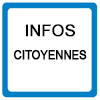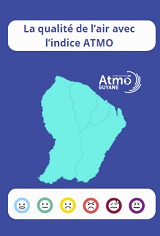Blada.com
dimanche 21 décembre
Boîtes aux lettres
Courrier des lecteurs
Petites annonces
Emploi / Formation
Covoiturage
Infos citoyennes
Infos citoyennes
15/04/20
Les petites bêtes des jardins de Guyane, bientôt en librairie !
 En pleine période de confinement, voilà un ouvrage qui tombe à pic ! L’Office national des forêts sort un nouvel ouvrage intitulé, Les petites bêtes des jardins de Guyane, un guide très illustré permettant une approche simple de la petite faune qui peuple les jardins et maisons de Guyane, avec de nombreuses anecdotes, photos et dessins.
En pleine période de confinement, voilà un ouvrage qui tombe à pic ! L’Office national des forêts sort un nouvel ouvrage intitulé, Les petites bêtes des jardins de Guyane, un guide très illustré permettant une approche simple de la petite faune qui peuple les jardins et maisons de Guyane, avec de nombreuses anecdotes, photos et dessins.
 Distribution prévue pour le moment dans certains points de ventes ouverts en cette période de confinement (supermarchés, librairie Case à bulle via commande à distance), à partir du 20 avril.
Distribution prévue pour le moment dans certains points de ventes ouverts en cette période de confinement (supermarchés, librairie Case à bulle via commande à distance), à partir du 20 avril.
La biodiversité ordinaire de nos jardins
De part leurs diversités incroyables, les animaux des jardins de Guyane valaient bien un ouvrage dédié. Le colibri butinant une fleur d’hibiscus est un parfait exemple de cette biodiversité dite ordinaire mais au combien passionnante et proche de chacun de nous.
Les auteurs : un ouvrage collaboratif
Cet ouvrage, dont la coordination éditoriale a été menée par l’ONF, est le fruit d’une collaboration d’une vingtaine de spécialistes, scientifiques, naturalistes.
Leur participation a permis d’aborder un maximum de famille d’insectes, mammifères et autres petites bêtes des jardins et de faire de cet ouvrage une référence à l’heure d’aujourd’hui sur le sujet, avec un réel travail de vulgarisation des information.
A découvrir dans le livre
Plus de 250 espèce sont abordées chez les gateropodes (escagots, limaces ..), insectes, arachnides (araignées, scorpions...), Myripaode (millepattes...), Amphibiens (crapauds, rainettes ...), reptiles, oiseaux et même quelques mamifères.
Cet ouvrage est une sorte de guide pédagogique pour découvrir cette faune de nos jardins. Il se décompose en trois grandes parties : une première partie de généralités présentant les jardins et les écosystèmes qu’ils constituent, une seconde partie organisée selon la classification systématique des espèces présente les espèces susceptibles d’être rencontrées dans les jardins et la troisième permet d’approfondir des sujets liés à ces espèces (espèces exotiques envahissantes, symbiose, chaînes alimentaire, écosystème des broméliacées.
Non exhaustif, il présente les espèces de manière compréhensible au plus grand nombre, tout en apportant un peu d’information plus pointue ou des pistes pour ceux qui veulent aller plus loin.
In full containment, this is a work not to be missed! The National Forest Office is releasing a new work entitled, "The little beasts of the gardens of French Guiana", a highly illustrated guide allowing a simple approach to the small fauna that populates the gardens and houses of French Guiana, with many anecdotes, photos and drawings.
Distribution planned for the moment in certain points of sale open during this period of confinement (supermarkets, Bookshop bubble box via remote control), from April 20.
The ordinary biodiversity of our gardens
Due to their incredible diversity, the animals in the gardens of French Guiana were well worth a dedicated work. The hummingbird foraging at a hibiscus flower is a perfect example of this so-called ordinary biodiversity, but very exciting and close to each of us.
The authors: a collaborative work
This work, whose editorial coordination was carried out by the NFB, is the fruit of the collaboration of some twenty specialists, scientists and naturalists.
Their participation made it possible to approach a maximum of family of insects, mammals and other small garden beasts and to make this work a reference to the time of today on the subject, with a real work of popularization of information.
To discover in the book
More than 250 species are approached in gateropods (escagots, slugs ...), insects, arachnids (spiders, scorpions ...), Myripaode (millipedes ...), Amphibians (toads, tree frogs ...), reptiles, birds and even some mammals.
This work is a kind of educational guide to discover this fauna of our gardens. It is broken down into three main parts: a first part of generalities presenting the gardens and the ecosystems which they constitute, a second part organized according to the systematic classification of species presents the species likely to be encountered in the gardens and the third allows to deepen subjects related to these species (invasive exotic species, symbiosis, food chains, bromeliad ecosystem.
Not exhaustive, it presents the species in a comprehensible way to the greatest number, while bringing a little more pointed information or leads for those who want to go further.
Raccourcis


passer une petite annonce

passer une annonce de covoiturage


passer une annonce d’emploi







associations, postez vos actualités

participez au courrier des lecteurs
La Guyane c’est ici
La qualité de l’Air avec
ATMO
Photothèque

Lancements 2022
Vol 259 Ariane 5




